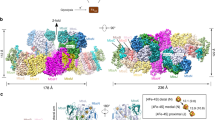Summary
The disulfide reducing activities of GSSG-and CoASSG-reductases were measured on partially purified extracts from a variety of prokaryotes and eukaryotes.
Glutathione-reductase was found in varying amounts in all eukaryotes and prokaryotes, used in this study, with the exception of the two strict anaerobesClostridium tartarivorum andDesulfovibrio vulgaris, and the two primitive ArchaebacteriaMethanosarcina barkeri andHalobacterium halobium.
CoASSG-reductase was found in some eukaryotes and prokaryotes, but showed no clear pattern of distribution other than its absence whenever GSSG-reductase was not present.
The absence of GSSG-reductase activity in organisms lacking GSH, confirms that glutathione metabolism is not universal and suggests that this enzyme might be useful as a marker in classifying organisms. The data suggest that glutathione-reductase occurs as a result of the change from a reducing to a oxidizing atmosphere in the primitive Earth.
Similar content being viewed by others
References
Apontoweil P, Berends W (1975) Isolation and initial characterization of glutathione-deficient mutants ofEscherichia coli. Biochim Biophys Acta 399:10–22
Arscott LD, Williams CH Jr, Schulz GE (1982) Pig heart lipoamide dehydrogenase and human erythrocyte glutathione reductase: homology in each of the three domains. In: Massey V, Williams CH Jr (eds) Flavins and flavoproteins, vol XXI. Elsevier North Holland, Amsterdam London, pp 44–48
Broda E (1975) The evolution of the bioenergetic processes. Pergamon International Library, Oxford New York Toronto, pp 53–63
Brown AD (1963) The peripheral structures of gram-negative bacteria. IV The cation-sensitive dissolution of the cell membrane of the halophilic bacterium,Halobacterium halobium. Biochim Biophys Acta 75:425–435
Cohen-Bazire G, Sistrom WR, Stanier RY (1957) Kinetic studies of pigment synthesis by non-sulfur purple bacteria. J Cell Comp Physiol 49(1):25–68
Davis, BD, Iningioli ES (1950) Multants ofEscherichia coli requiring methionine or vitamin B12. J Bacteriol 60(1):17–28
Fahey RC (1977) Biologically important thiol-disulfide reactions and the role of cyst(e)ine in proteins: an evolutionary perspective. In: Friedman M (ed) Protein crosslinking biochemical and molecular aspect (part A). Plenum Publishing Corp, New York, pp 1–30
Fahey RC, Brown WC, Adams WB, Worsham MB (1978) Occurrence of glutathione in bacteria. J Bacteriol 133(3):1126–1129
Fuchs JA, Warner HR (1975) Isolation of anEscherichia coli mutant deficient in glutathione synthesis. J Bacteriol 124(1):140–148
Golecki JR, Drews G (1980) Cellular organization of the halophilic, phototrophic bacterium strain WS 68. Eur J Cell Biol 22(2):654–660
Lanyi JK (1969) Studies of the electron transport chain of extremely halophilic bacteria. III Mechanism of the effect of salt on menadione reductase. J Biol Chem 244(15):4168–4173
Loewen PC (1981) Effect of glutathione deficiency on the pool of CoA-glutathione mixed disulfide inEscherichia coli. Can J Biochem 59(5):379–382
Lowry OH, Rosebrough NJ, Farr AL, Randall RJ (1951) Protein measurement with the Folin phenol reagent. J Biol Chem 193(1):265–275
Miller SL, Orgel LE (1974) The origins of life on the earth. Prentice-Hall, New Jersey, pp 33–52
Ondarza RN (1965) Characterization of a nucleotide-peptide from rat liver. Biochim Biophys Acta 107:112–119
Ondarza RN, Abney R, López Colomé AM (1969) Characterization of a NADPH-depedent coenzyme A-SS-glutathione reductase from veast. Biochim Biophys Acta 191:239–248
Ondarza RN (1970) Preparation and assay of CoA-SS-glutathione. In: Colowick SP, Kaplan NO (eds) Methods in enzymology, vol XVIII (part A). Academic Press, New York London, pp 318–322
Ondarza RN, Escamilla E, Gutiérrez J, De La Chica G (1974) CoA-SS-glutathione and GSSG reductases from rat liver. Two disulfide oxidoreductase activities in one protein entity. Biochim Biophys Acta 341:162–171
Sehgal SN, Gibbons NE (1960) Effect of some metal ions on the growth ofHalobacterium cutirubrum. Can J Microbiol 6(2):165–169
Urey HC (1952) On the early chemical history of the earth and the origin of life. Proc Natl Acad Sci USA 38:351–363
Webb EC (1964) Report of the commission on enzymes of the International Union of Biochemistry. In: Florkin M, Stotz EH (eds) Comprehensive biochemistry, vol XIII. Elsevier Publishing Company, Amsterdam London New York, p 8
Woese CR, Magrum LJ, Fox GE (1978) Archaebacteria. J Mol Evol 11:245–252
Author information
Authors and Affiliations
Additional information
A great part of this work was carried out by R.N. Ondarza, during his sabbatical leave at Scripps Institution of Oceanography, La Jolla
Recipient of a grant by the Centro de Investigación en Química Aplicada at Saltillo, Coahuila, Mexico
Rights and permissions
About this article
Cite this article
Ondarza, R.N., Rendón, J.L. & Ondarza, M. Glutathione reductase in evolution. J Mol Evol 19, 371–375 (1983). https://doi.org/10.1007/BF02101641
Received:
Revised:
Issue Date:
DOI: https://doi.org/10.1007/BF02101641




